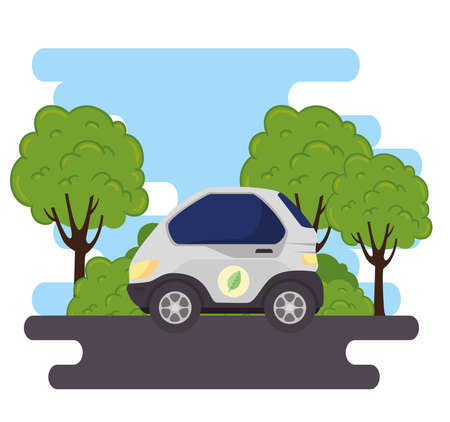1. Introduction to AI-Powered Safety Features
Artificial intelligence (AI) is transforming the way we drive, making roads safer and reducing accidents. Thanks to AI-powered safety features, modern vehicles can detect dangers earlier, respond faster, and assist drivers in making better decisions. These innovations are not just futuristic concepts—they are already integrated into many cars today, helping drivers avoid collisions and making travel safer for everyone.
How AI Improves Vehicle Safety
AI enhances vehicle safety by analyzing real-time data from sensors, cameras, and radar systems. It helps vehicles react to potential hazards before a driver even notices them. Here are some key ways AI is improving road safety:
| AI Feature | Function | Safety Benefit |
|---|---|---|
| Automatic Emergency Braking (AEB) | Detects obstacles and applies brakes if a crash is imminent. | Reduces rear-end collisions and impact severity. |
| Lane Departure Warning (LDW) | Alerts drivers if they unintentionally drift out of their lane. | Helps prevent accidents caused by distracted or drowsy driving. |
| Adaptive Cruise Control (ACC) | Maintains a safe distance from the vehicle ahead by adjusting speed. | Reduces the risk of rear-end collisions and improves highway safety. |
| Blind Spot Monitoring | Detects vehicles in the drivers blind spots and provides alerts. | Reduces lane-change collisions. |
The Role of Machine Learning in Vehicle Safety
Machine learning, a type of AI, plays a crucial role in vehicle safety by continuously learning from real-world driving data. This allows AI systems to improve over time, recognizing patterns that indicate possible dangers. For example, AI can analyze driving behavior to predict when a driver may be drowsy and issue a warning before an accident occurs.
Real-World Impact of AI on Road Safety
Studies show that AI-powered safety features significantly reduce accidents. According to industry reports, vehicles equipped with automatic emergency braking and lane departure warnings experience fewer crashes compared to those without. As AI technology advances, we can expect even safer roads in the future.
2. Advanced Driver Assistance Systems (ADAS)
Advanced Driver Assistance Systems (ADAS) use AI-powered technology to enhance road safety and provide drivers with extra support. These systems help prevent accidents, reduce driver fatigue, and make driving more convenient. Below are some key AI-driven safety features commonly found in modern vehicles.
Lane-Keeping Assist (LKA)
Lane-Keeping Assist (LKA) helps drivers stay in their lane by detecting lane markings on the road. If the system senses that the vehicle is unintentionally drifting out of its lane, it provides gentle steering corrections to guide the car back to the center. This feature is especially useful on highways and during long drives, helping to prevent accidents caused by distracted or drowsy driving.
Adaptive Cruise Control (ACC)
Adaptive Cruise Control (ACC) is an advanced version of traditional cruise control. It does more than maintain a set speed—it automatically adjusts the speed based on traffic conditions. Using sensors and AI, ACC detects vehicles ahead and adapts the speed to maintain a safe following distance. It can slow down or accelerate as needed, making highway driving smoother and reducing the risk of rear-end collisions.
Automatic Emergency Braking (AEB)
Automatic Emergency Braking (AEB) enhances safety by detecting potential collisions and applying the brakes if the driver does not react in time. The system uses cameras, radar, and AI to monitor the road ahead. If it detects a sudden obstacle—like a stopped vehicle or a pedestrian—it can reduce speed or bring the car to a complete stop. This feature helps minimize the severity of accidents and, in some cases, can prevent them entirely.
Comparison of AI-Powered ADAS Features
| Feature | Function | Benefit |
|---|---|---|
| Lane-Keeping Assist (LKA) | Detects lane markings and prevents drifting | Reduces lane departure accidents |
| Adaptive Cruise Control (ACC) | Adjusts speed based on traffic flow | Makes highway driving safer and smoother |
| Automatic Emergency Braking (AEB) | Applies brakes to avoid collisions | Reduces crash severity or prevents collisions |
With AI-powered safety features like LKA, ACC, and AEB, vehicles are becoming smarter and more capable of assisting drivers. These technologies help reduce the risk of accidents and create a safer driving experience for everyone on the road.

3. Three, Real-Time Hazard Detection and Prevention
AI-powered safety features help drivers stay alert to potential dangers by using advanced sensors, cameras, and predictive analytics. These technologies work together to continuously monitor the vehicle’s surroundings and provide real-time warnings or automatic interventions to prevent accidents.
How AI Enhances Situational Awareness
Traditional safety systems rely on human reaction times, which can vary depending on distractions, fatigue, or road conditions. AI, on the other hand, uses a combination of technologies to improve situational awareness and mitigate risks more effectively.
Key Technologies Used in Real-Time Hazard Detection
| Technology | Function |
|---|---|
| Sensors | Detect objects, movements, and road conditions |
| Cameras | Provide visual data for lane detection, obstacle identification, and pedestrian recognition |
| Predictive Analytics | Analyze patterns to anticipate potential hazards before they become threats |
Preventing Accidents Before They Happen
AI-driven hazard detection doesn’t just alert drivers; it also takes action when needed. Advanced Driver Assistance Systems (ADAS) use automated braking, lane-keeping assistance, and collision avoidance to intervene when a driver doesn’t react in time.
Examples of AI-Powered Preventive Actions
- Automatic Emergency Braking (AEB): Detects imminent collisions and applies the brakes automatically.
- Lane Departure Warning (LDW): Alerts the driver if the car drifts out of its lane without signaling.
- Adaptive Cruise Control (ACC): Adjusts speed based on real-time traffic conditions to maintain a safe following distance.
The Road Ahead for AI Safety Features
As AI technology continues to advance, hazard detection and prevention systems will become even more sophisticated. Future enhancements may include real-time communication between vehicles and infrastructure, further reducing the chances of accidents and making roads safer for everyone.
4. The Role of Machine Learning in Accident Prevention
Artificial intelligence, particularly machine learning, plays a crucial role in preventing accidents on the road. By analyzing vast amounts of driving data, AI can predict potential hazards, assist drivers in making safer decisions, and continuously improve vehicle safety systems.
How AI Learns from Data
AI-powered safety systems rely on data collected from various sources, including sensors, cameras, and GPS. Machine learning algorithms process this information to recognize patterns in driver behavior, identify common accident scenarios, and suggest corrective actions.
Key Data Sources for AI
| Data Source | Function |
|---|---|
| Vehicle Sensors | Monitor speed, braking, and steering |
| Cameras | Detect pedestrians, lane markings, and traffic signals |
| GPS & Traffic Data | Provide real-time road conditions and congestion updates |
| Driver Monitoring Systems | Identify drowsiness or distracted driving |
Improving Driver Behavior with AI
AI doesn’t just react to dangers; it actively helps drivers improve their habits. For example, some systems give real-time feedback on driving styles, alerting drivers if they are speeding, following too closely, or making abrupt lane changes. Over time, AI can tailor driving recommendations based on individual behaviors.
Examples of AI Safety Features
- Adaptive Cruise Control: Adjusts speed based on traffic flow
- Lane Departure Warning: Alerts drivers if they drift out of their lane
- Automated Emergency Braking: Stops the vehicle if a collision is imminent
- Driver Attention Monitoring: Detects signs of distraction or fatigue
The Future of AI in Road Safety
As machine learning technology advances, AI systems will become even better at preventing accidents. Future developments may include real-time hazard detection, personalized driving coaching, and even fully autonomous accident prevention systems. By continuously learning from real-world data, these technologies have the potential to make roads significantly safer for everyone.
5. Future of AI in Automotive Safety
Artificial intelligence is rapidly transforming vehicle safety, and the future looks even more promising. From advanced driver assistance systems to fully autonomous vehicles, AI-powered innovations will continue to enhance road safety and reduce accidents. Here are some key predictions on how AI will shape automotive safety in the near future:
Enhanced Driver Monitoring Systems
AI-driven driver monitoring systems are expected to become more sophisticated. These systems will use advanced cameras and sensors to track eye movements, facial expressions, and driver behavior to detect drowsiness, distraction, or impairment more accurately.
Real-Time Hazard Detection
Future vehicles will feature AI-powered systems capable of identifying road hazards faster than human drivers. These technologies will integrate real-time data from multiple sources such as cameras, LiDAR, weather reports, and traffic analytics to predict and avoid potential dangers.
Vehicle-to-Everything (V2X) Communication
AI will play a crucial role in Vehicle-to-Everything (V2X) communication, enabling cars to interact with other vehicles, infrastructure, pedestrians, and even cyclists. This connectivity will allow vehicles to anticipate traffic conditions, road obstacles, and sudden changes, ultimately preventing collisions.
Autonomous Emergency Maneuvers
Future AI systems will not just assist but also take protective actions in critical situations. Vehicles will be able to autonomously make emergency lane changes or apply brakes to avoid potential crashes more effectively.
Predicted AI Innovations and Safety Impact
| AI Innovation | Expected Safety Benefit |
|---|---|
| Advanced Driver Monitoring | Reduces accidents caused by drowsy or distracted driving |
| Real-Time Hazard Detection | Prevents collisions by identifying dangers earlier |
| V2X Communication | Enhances situational awareness and improves traffic flow |
| Autonomous Emergency Maneuvers | Minimizes crash severity and prevents accidents |
As AI technology continues to evolve, its integration into automotive safety will bring significant improvements in accident prevention and road safety. In the coming years, these advancements will make driving safer for everyone, reducing fatalities and enhancing overall traffic efficiency.

